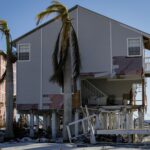Insured losses from the magnitude 9.0 earthquake and tsunami that struck Japan last Friday are between $12 billion and $25 billion, according to catastrophe modeler EQECAT. In its latest update, the firm describes the losses as “significant.”
The figures are lower than those previously announced by another firm, AIR Worldwide, which estimated insured losses at between $15 billion and $35 billion.
In its fourth update on the tragedy, EQECAT said that the earthquake, which has been upgraded from M8.9 to M9 by the Japan Meteorological Agency (JMA), is the “most powerful to hit Japan since record keeping began” and the massive tsunami it triggered “swept away cars, structures, and ships, as well as impacting coastal towns as far across the Pacific in Northern California.”
EQECAT’s $12 billion to $25 billion estimate of the total insured loss includes $2 billion to $4 billion of total insured loss, which is expected to be ceded to the Japan Earthquake Reinsurance Pool (JERP), which will reduce the total losses to non-life property insurers in Japan. This loss estimate encompasses the effects of earthquake shaking, ensuing tsunami and fires, and losses to automobiles, marine, life and personal accident insurance lines.
The largest component of insured loss will be covered by the property insurance market, which provides earthquake insurance to individuals and businesses in Japan. EQECAT breaks down the respective loss categories by line of business as follows:
- EQ Shake – $8 to $15 billion (Estimated 25 percent ceded to JERP)
- Auto – $0 to $1 billion
- Marine – $1 to $3 billion
- Life – $2 to $3 billion
- Personal Accident – $1 to $2 billion
These estimates do not account for losses associated with the current nuclear emergency at power plants in the region.
EQECAT said that shake losses are calculated using its market loss portfolio. Tsunami flooding losses are modeled as covered under the earthquake policy endorsement. Residential and shop-owner policies written by the non-life insurance companies are ceded to the Japanese Earthquake Reinsurance Pool, the firm said.
The earthquake endorsement for dwelling risks provides cover for tsunami losses. However, the general risks require an endorsement for earthquake coverage and another endorsement for tsunami losses. This Earthquake Water Damage Coverage Endorsement is not purchased by all policyholders carrying the Earthquake Coverage Endorsement, according to EQECAT.
Also, Earthquake Fire Expenses Insurance is automatically provided for all fire policies except for warehouse risks. In addition to the fire following coverage that it provides, this form also provides coverage for tsunami losses for all dwelling and general risks.
The modeling firm noted that losses to policies written by the various Kyosai, industrial losses by non-life companies, and losses to international insurers are not ceded to the Japanese Earthquake Reinsurance Pool.
The Fire and Disaster Management Agency said the number of buildings completely or partially destroyed by the earthquake had reached 75,000 as of 11:00 p.m. JST Monday. “This is an early tally,” noted EQECAT, adding that by comparison the 1995 Great Hanshin Earthquake partially or completely destroyed 500,000 buildings.
Although a large number of automobiles were swept away by the tsunami, coverage for their loss may be limited. According to EQECAT, the standard auto policy excludes earthquake coverage. “This cover can be purchased, but is usually done for fleets or dealerships. Although a large number of cars were damaged in the aftermath of the earthquake by the raging tsunami waves, few of these cars will have earthquake coverage. It is estimated that as low as 10,000 cars and as high as 50,000 cars will be affected by the earthquake,” the firm said.
Marine includes an estimate of losses to ships, piers, wharves including equipment attached to piers and wharves. “There are reports of 90 large commercial vessels, and thousands of smaller vessels that have been pushed far inland by the tsunami,” EQECAT said.
EQECAT said it made no adjustment to account for access restrictions due to the evacuation zones around the Fukushima nuclear plants.
The number of people who perished in the disaster has been growing. At least 10,000 are currently confirmed dead or missing, and the number is likely to increase. EQECAT noted that the average life insurance policy limit is about $360,000 and that if 100 percent of those confirmed dead or missing are insured, life insurers will be liable for as much as $3 billion.
Personal accident insurers will compensate those who are injured from this event. Tallies are currently being assessed, but EQECAT believes a large portion of the displaced population has been exposed to potential injuries. As of Monday, March 14, an estimated 450,000 people were living in emergency shelters.
Was this article valuable?
Here are more articles you may enjoy.


 DeSantis Signs Bill Barring Local Worker Heat Protection Measures
DeSantis Signs Bill Barring Local Worker Heat Protection Measures  Florida Public Adjuster, Renter Charged With Filing Claim on Rental Home
Florida Public Adjuster, Renter Charged With Filing Claim on Rental Home  If US Inflation Reflected Rising Home Insurance Costs, It’d Be Even Higher
If US Inflation Reflected Rising Home Insurance Costs, It’d Be Even Higher  Florida Peninsula Says Reforms Have Had an Impact, Announces 2% Rate Cut
Florida Peninsula Says Reforms Have Had an Impact, Announces 2% Rate Cut 

